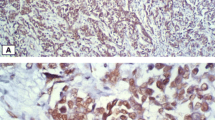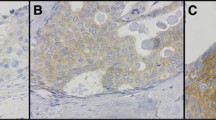Abstract
In breast cancer, the prognostic impact of COX2 expression varies widely between studies. We examined the prognostic value of COX2 expression in a large cohort of breast cancer patients treated with primary surgery between 1985 and 1994 and explained the variable results of COX2 expression found in the literature. A tissue microarray was constructed of available tumour material, and ER, PgR, HER2, Ki67 and COX2 were examined by immunohistochemistry. Median follow-up was 19 years. Fifty-five percent (n = 369/677) of patients received no systemic treatment. COX2 was scored using a weighted histoscore. Analysis of COX2 expression in two groups based on the median (148; below vs. above) showed an increased hazard ratio (HR) of 1.35 (95% CI 1.05–1.75, P = 0.021) for disease-free survival (DFS) and of 1.39 (95% CI 1.03–1.82, P = 0.016) for overall survival (OS). However, COX2 did not remain independent in multivariate analysis. In patients with hormone receptor positive tumours, COX2 expression had a negative influence on outcome (low vs. high: DFS: HR 1.37, 95% CI 1.07–1.76, P = 0.013). This effect disappeared when endocrine therapy was administered (low vs. high: DFS: HR 0.93, 95% CI 0.51–1.70, P = 0.811) while it remained statistically significant when endocrine therapy was omitted (low vs. high: DFS: HR 1.48, 95% CI 1.12–1.94, P = 0.005). Our results show that COX2 plays a role in hormonal pathways. Our results can explain the results found in previously published studies.





Similar content being viewed by others
References
Parkin DM, Bray F, Ferlay J, Pisani P (2005) Global cancer statistics, 2002. CA Cancer J Clin 55:74–108
Early Breast Cancer Trialists’ Collaborative Group (2005) Effects of chemotherapy and hormonal therapy for early breast cancer on recurrence and 15-year survival: an overview of the randomised trials. Lancet 365:1687–1717
Goldhirsch A, Wood WC, Gelber RD et al (2007) Progress and promise: highlights of the international expert consensus on the primary therapy of early breast cancer 2007. Ann Oncol 18:1133–1144
Harris RE, Chlebowski RT, Jackson RD et al (2003) Breast cancer and nonsteroidal anti-inflammatory drugs: prospective results from the Women’s Health Initiative. Cancer Res 63:6096–6101
Khuder SA, Mutgi AB (2001) Breast cancer and NSAID use: a meta-analysis. Br J Cancer 84:1188–1192
Rolland PH, Martin PM, Jacquemier J et al (1980) Prostaglandin in human breast cancer: evidence suggesting that an elevated prostaglandin production is a marker of high metastatic potential for neoplastic cells. J Natl Cancer Inst 64:1061–1070
Boland GP, Butt IS, Prasad R et al (2004) COX-2 expression is associated with an aggressive phenotype in ductal carcinoma in situ. Br J Cancer 90:423–429
Costa C, Soares R, Reis-Filho JS et al (2002) Cyclo-oxygenase 2 expression is associated with angiogenesis and lymph node metastasis in human breast cancer. J Clin Pathol 55:429–434
Denkert C, Winzer KJ, Muller BM et al (2003) Elevated expression of cyclooxygenase-2 is a negative prognostic factor for disease free survival and overall survival in patients with breast carcinoma. Cancer 97:2978–2987
Haffty BG, Yang Q, Moran MS et al (2008) Estrogen-dependent prognostic significance of cyclooxygenase-2 expression in early-stage invasive breast cancers treated with breast-conserving surgery and radiation. Int J Radiat Oncol Biol Phys 71:1006–1013
Half E, Tang XM, Gwyn K et al (2002) Cyclooxygenase-2 expression in human breast cancers and adjacent ductal carcinoma in situ. Cancer Res 62:1676–1681
Hwang D, Scollard D, Byrne J, Levine E (1998) Expression of cyclooxygenase-1 and cyclooxygenase-2 in human breast cancer. J Natl Cancer Inst 90:455–460
Kelly LM, Hill AD, Kennedy S et al (2003) Lack of prognostic effect of Cox-2 expression in primary breast cancer on short-term follow-up. Eur J Surg Oncol 29:707–710
O’Connor JK, Avent J, Lee RJ et al (2004) Cyclooxygenase-2 expression correlates with diminished survival in invasive breast cancer treated with mastectomy and radiotherapy. Int J Radiat Oncol Biol Phys 58:1034–1040
Park K, Han S, Shin E et al (2006) Cox-2 expression on tissue microarray of breast cancer. Eur J Surg Oncol 32:1093–1096
Ristimaki A, Sivula A, Lundin J et al (2002) Prognostic significance of elevated cyclooxygenase-2 expression in breast cancer. Cancer Res 62:632–635
Schmitz KJ, Callies R, Wohlschlaeger J et al (2006) Overexpression of cyclo-oxygenase-2 is an independent predictor of unfavourable outcome in node-negative breast cancer, but is not associated with protein kinase B (Akt) and mitogen-activated protein kinase (ERK1/2, p38) activation or with Her-2/neu signalling pathways. J Clin Pathol 59:685–691
Singh-Ranger G, Jewell A, Thomas V, Mokbel K (2004) Elevated expression of cyclooxygenase-2 in breast cancer and ductal carcinoma in situ has no correlation with established prognostic markers. J Surg Oncol 88:100–103
Soslow RA, Dannenberg AJ, Rush D et al (2000) COX-2 is expressed in human pulmonary, colonic, and mammary tumors. Cancer 89:2637–2645
Spizzo G, Gastl G, Wolf D et al (2003) Correlation of COX-2 and Ep-CAM overexpression in human invasive breast cancer and its impact on survival. Br J Cancer 88:574–578
Witton CJ, Hawe SJ, Cooke TG, Bartlett JM (2004) Cyclooxygenase 2 (COX2) expression is associated with poor outcome in ER-negative, but not ER-positive, breast cancer. Histopathology 45:47–54
Zerkowski MP, Camp RL, Burtness BA et al (2007) Quantitative analysis of breast cancer tissue microarrays shows high cox-2 expression is associated with poor outcome. Cancer Invest 25:19–26
Dubois RN, Abramson SB, Crofford L et al (1998) Cyclooxygenase in biology and disease. FASEB J 12:1063–1073
McShane LM, Altman DG, Sauerbrei W et al (2005) Reporting recommendations for tumor marker prognostic studies. J Clin Oncol 23:9067–9072
Leyland-Jones BR, Ambrosone CB, Bartlett J et al (2008) Recommendations for collection and handling of specimens from group breast cancer clinical trials. J Clin Oncol 26:5638–5644
Bartlett J, Mallon E, Cooke T (2003) The clinical evaluation of HER-2 status: which test to use? J Pathol 199:411–417
Camp RL, Charette LA, Rimm DL (2000) Validation of tissue microarray technology in breast carcinoma. Lab Invest 80:1943–1949
Henriksen KL, Rasmussen BB, Lykkesfeldt AE et al (2007) Semi-quantitative scoring of potentially predictive markers for endocrine treatment of breast cancer: a comparison between whole sections and tissue microarrays. J Clin Pathol 60:397–404
Kirkegaard T, Edwards J, Tovey S et al (2006) Observer variation in immunohistochemical analysis of protein expression, time for a change? Histopathology 48:787–794
Kirkegaard T, Witton CJ, McGlynn LM et al (2005) AKT activation predicts outcome in breast cancer patients treated with tamoxifen. J Pathol 207:139–146
Faratian D, Kay C, Robson T et al (2009) Automated image analysis for high-throughput quantitative detection of ER and PR expression levels in large-scale clinical studies: the TEAM Trial Experience. Histopathology 55(5):587–593
Turbin DA, Leung S, Cheang MC et al (2008) Automated quantitative analysis of estrogen receptor expression in breast carcinoma does not differ from expert pathologist scoring: a tissue microarray study of 3,484 cases. Breast Cancer Res Treat 110:417–426
Altman DG, Machin D, Bryant TN, Gardner MJ (2000) Statistics with confidence. British Medical Journal Books, Bristol
Early Breast Cancer Trialists’ Collaborative Group (1998) Tamoxifen for early breast cancer: an overview of the randomised trials. Lancet 351:1451–1467
Acknowledgements
We thank Fiona Campbell, Alison Munro, Johanna Pedraza, InHwa Um and other colleagues of the Endocrine Cancer Group for their help in the laboratory. We thank Jan Molenaar for help with the database and Klaas van der Ham for pictures of immunohistochemistry-stained slides. This research has been supported by grants of the Dutch Surgical Foundation ‘Stichting Prof. Michaël-van Vloten Fonds’, by the Foundation ‘De Drie Lichten’ in the Netherlands and by an unrestricted educational research grant of Pfizer UK.
Author information
Authors and Affiliations
Corresponding author
Rights and permissions
About this article
Cite this article
van Nes, J.G.H., de Kruijf, E.M., Faratian, D. et al. COX2 expression in prognosis and in prediction to endocrine therapy in early breast cancer patients. Breast Cancer Res Treat 125, 671–685 (2011). https://doi.org/10.1007/s10549-010-0854-7
Received:
Accepted:
Published:
Issue Date:
DOI: https://doi.org/10.1007/s10549-010-0854-7




